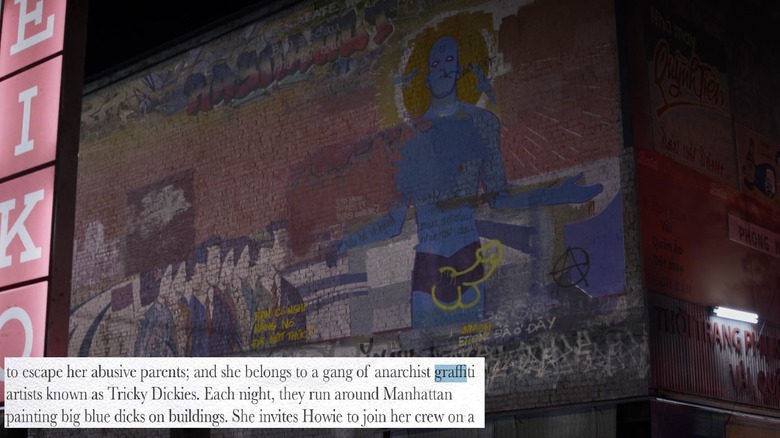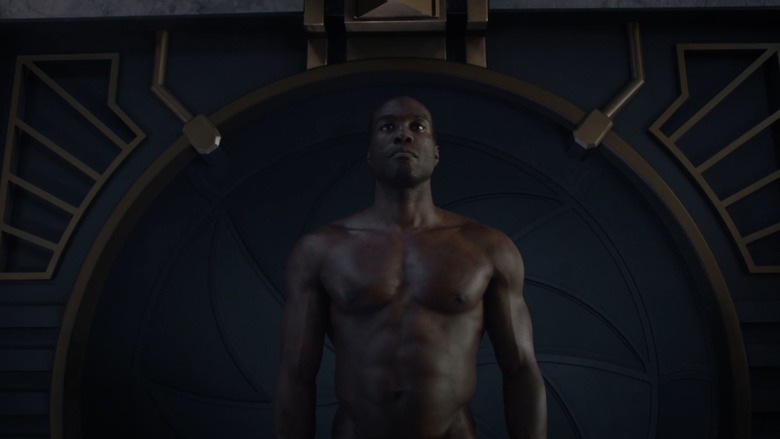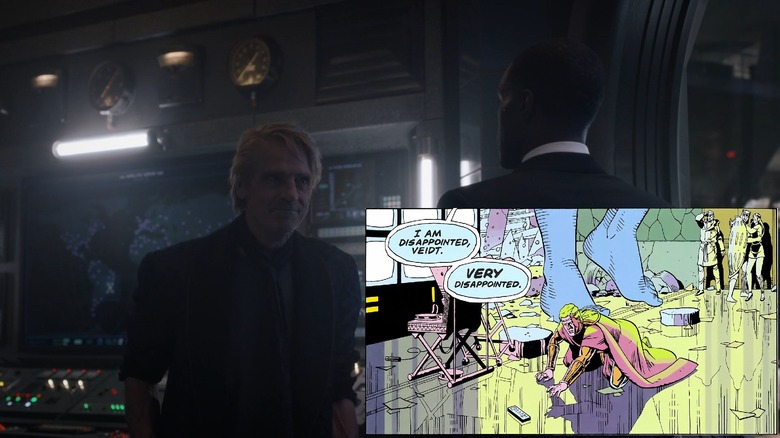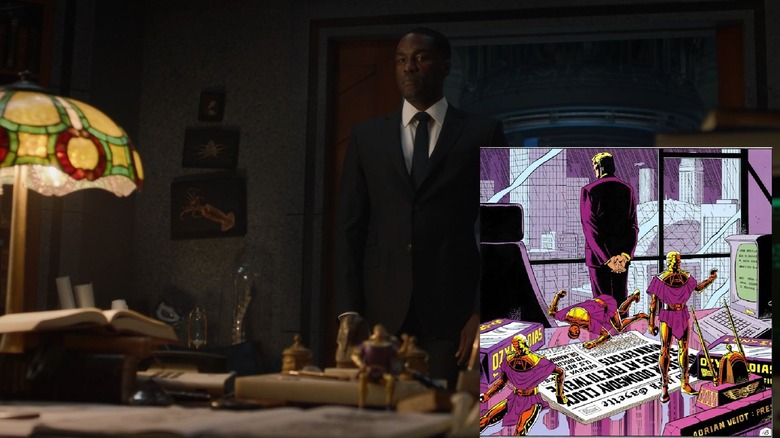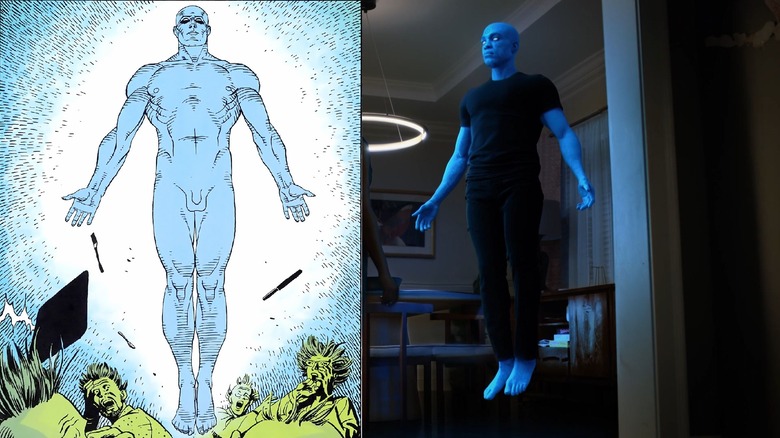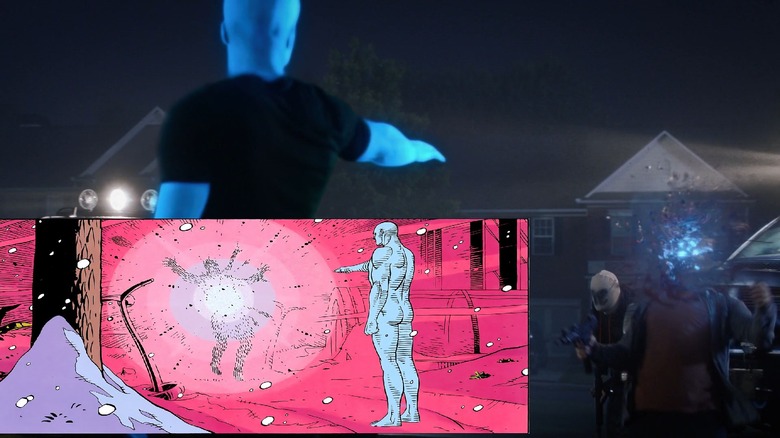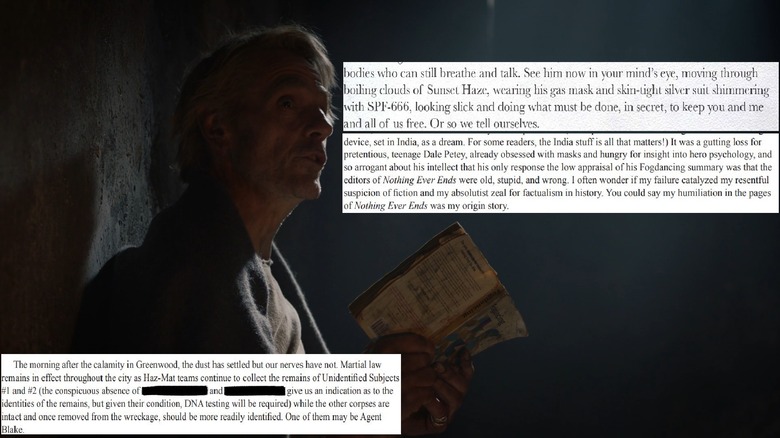The 'Watchmen' Reference Guide: Every Easter Egg In "A God Walks Into Abar"
It finally happened. Just like with Lost, and The Leftovers, Damon Lindelof revealed he was using the mystery and the craziness of Watchmen just to tell a sweet love story – this time between a woman and a god.
And what a love story it was, as Chris Evangelista puts it in his recap of the episode, "Watchmen becomes unstuck in time." Though a bit lighter in easter eggs than previous episodes, there's still some nods and references to the graphic novel. So join us, won't you? Let's look at all the references to the original Watchmen and more in "A God Walks Into Abar." As always, this will be spoiler-heavy.
Big Blue (Kind Of)
Lindelof and his team kept teasing Doctor Manhattan's full birthday suit this week, as the episode starts with Doctor Manhattan walking by a wall painting of himself "liberating" the Vietnamese now defaced (or improved?) with a graffiti of his penis (painted in Watchmen yellow).
This week's Peteypedia entries, the online supplement that fleshes out the show's universe, include a summary of Fogdancing (more on that later) that explains the existence of a gang of anarchist graffiti artists known as Tricky Dickies, who run around painting big dicks on buildings. Oh, Watchmen, how we're going to miss you when you're gone.
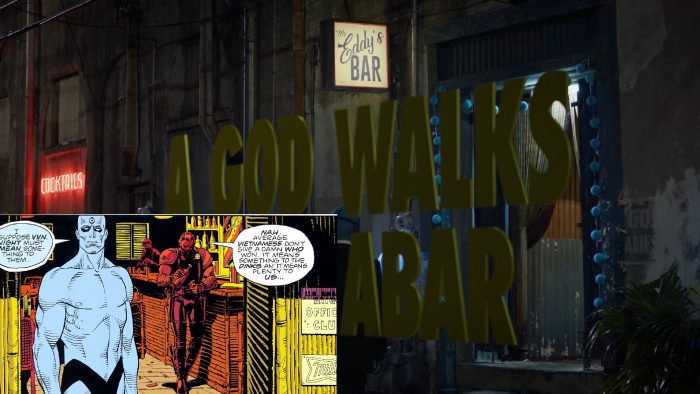
Eddy's bar
This one was trickier. There's not really a lot in the bar Doctor Manhattan walks into that signals it's the same bar seen in the comics, and the spelling is different, but we're just going to take episode director and executive producer Nicole Kassell's word for it. In an interview with Polygon, she confirms "the bar is from the source comic, Eddie's bar in Vietnam. Time has passed, and now a city's grown up around it. When Doctor Manhattan walks into the bar, there's a sign that says "Eddy's," and the set dressing is inspired by panels from that sequence in the comic."
This refers not to the name of the bar, but to the bar where "Eddie" or Edward Blake, AKA The Comedian (AKA Laurie's father), and Doctor Manhattan talk before Eddie murders a pregnant woman in issue #2. This was the sequence where we first start to read about Doctor Manhattan not caring about humans and becoming more and more detached.
Full Doctor Manhattan’s Frontal
After endless teasing, this episode gives us Doctor Manhattan in all his blue glory, only it's from the back or in the background. Then we see him swing all his atoms around once he takes Cal's form. It's a good compromise, and a great way of playing with the audience's expectations.
A Very Disappointed Doctor Manhattan
Doctor Manhattan recalls how Adrian Veidt tried to kill him in the last issue of the original Watchmen by luring him into an Intrinsic Field Generator, the machine that gave him his powers, to disintegrate him. Except the plan failed and a reassembled Doctor Manhattan told Veidt that he was "very disappointed" in him.
Ozymandias Action Figures
As Veidt picks up the device that will turn Doctor Manhattan into a mortal, we see a little Ozymandias action figure. This brings to mind issue #1 of the graphic novel where we first see Adrian Veidt, standing in his New York City corporate headquarters, with a bunch of action figures in his desk.
Floating Doctor Manhattan
When the show finally catches up to the present and Jon wakes up, revealing to us Doctor Manhattan's iconic blue look, it does so by replicating the iconic pose from issue #4 of the original Watchmen. In the comic, spending months trying to rebuilt a body for himself, Doctor Manhattan finally materializes in the middle of a cafeteria, floating mid-air just like Cal/Jon does in the episode.
Exploding Bodies
When Doctor Manhattan goes out and saves Angela from the Seventh Kavalry, he does so by literally making all their heads explode. This is the same method of execution he used on Rorschach in the final issue of Watchmen, as he just waves his hand and Walter Kovacs explodes.
This week's Peteypedia also shed some light on the aftermath of this massacre. According to Dale Petey, Martial law was declared as Haz-Mat teams worked on collecting the remains of "Unidentified Subjects #1 and #2." This is curious since we saw way more than two people die in the episode. Also, two names are written in the report, then blacked out. Did the Seventh Kavalry also take Angela? We'll find out next week.
Fogdancing and Lube Man?
In the episode's post-credits scene, we see Adrian Veidt reading Max Shea's Fogdancing, a book that has already appeared several times in the course of the show. Well, this week's Peteypedia had a lot to say about that novel. For one, the novel loosely follows the same plot as the original Watchmen, with plans of saving the world via mutant leviathans, vigilante groups, and also a Jacob's Ladder twist.
According to Petey, many masked vigilantes owned copies of the book, including The Comedian and Rorschach. Even Doctor Manhattan quoted the book at times. The novel was apparently turned into a film twice, once directed by the Brothers Quay, and once by David Cronenberg. More curiously, the memo mentions a third adaptation by the creator of American Hero Story, who "remixed" the source material (very much like Watchmen).
The best part comes in a second document, where Petey summarizes the story of "Fogdancing" which reveals that the title refers to a secret military group of super soldiers who wore "skin-tight silver suits" that resisted the book's version of napalm. Is this definitive proof that Petey is actually Lube Man? In his memo, he does allude to his failure at winning a contest with his summary being his origin story. Or does this mean there's more than one Lube Man? And did Adrian Veidt base his world-saving plot from a novel? Nothing ever ends indeed.

